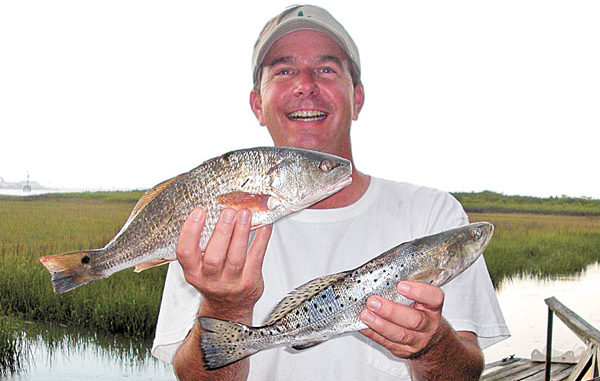
What’s most important about fishing during the spring is to take what the water gives you in terms of fish, release the small ones and work your way up to bigger fish.
Believe me, after a cold winter that did not produce a lot of battles with fish for most anglers, a small pull or a light drag scream will be enough to get them back into making routine stops by the tackle shop.
It’s not impossible to catch a whopper early in the spring, but it is far more likely that some smaller fish will be encountered first. As baits like mud minnows, tiny shrimp and young finger mullet make their returns to the creeks, anglers can rest assured that small flounder, trout and redfish will follow them there.
How small are these baits that arrive first? They’re big enough to make a small wake in the water as they swim past, but so small that a cast net would be practically useless, because the smallest mesh is too big. Minnow traps can serve to gather some of the smallest minnows, but they may not yet be big enough to get on a saltwater hook. And forget about getting the krill shrimp on any hook.
It seems that everything starts small and works its way up, and anglers should accept this as normal. Wading birds that patrol the creek banks have to work a little harder to catch these smallest of minnows and crabs, but they welcome the change in diet and know that larger portions will soon be served up. Anglers who swing for the fences on their first few casts of spring are more likely to have damaged egos than those looking for “any fish.”
A great-looking hard bait to use in early spring might be the smallish MirrOlure MirrOdine, or anything similar. No need to tie on a big topwater plug and splash it around unless you are looking to entertain others by showing how many fish you can spook from an area. The fish will be keyed in on small baits, and while they may take a large one under the right conditions, experience says to fish small.
Does an elephant eat peanuts? You bet, and these same small baits can work on bigger fish on down the road in May and June, so sharpening your cadence by using them in early spring can reap dividends down the road when you need to make a “money” cast and retrieve for a fish with shoulders. Those head-shaking fights of summer when rods are doubled over will come in time.
Try fishing an old reliable spot first in the spring, one that is known to you or a trustworthy friend to be good each and every year. But also remember to try a different spot here and there in order to prospect for some more action. Fishing spots are a hot topic with more and more fishing pressure these days, and whether using technology or not, it’s up to an angler to find a spot that produces fish.
Maybe after an early spring outing you have a strikeout, even though you gave it your best shot. Act natural, brother; anybody who has not admitted striking out a time or two can keep a secret better than the CIA. Now, if after five or more trips without a bite, it might be time to book a guided trip or even take up spring gardening, but don’t take one strikeout too hard. Just get back after them, perhaps even in the same spots, because persistence pays in saltwater fishing.
Before leaving the docks again and again in the summer with buddies going on die-hard “fishing missions,” think of taking others fishing in early spring. The first warm weather beckons female anglers and even children to get in the boat for a ride or maybe even to fish. If you think it would be great to take some photos of them holding fish, then early spring is the time. These smaller fish fit better in the hands of children and women, which allows them to hold them much better and enjoy the photo op. Most will be satisfied with that photo for the remainder of the year, but every now and then we get lucky and “catch” a new saltwater angler to join and bolster the ranks.
Spring fishing can be great inshore, and water temperatures should be watched in order not to miss any threshhold events that usher in different species of migratory fish. Check SouthCarolinaSportsman.com for inshore fishing reports, and if you don’t see the answer you’re looking for, simply place your question on the forum and it will be addressed. The time when the first Spanish mackerel are caught at a pier is different from the time the first Spaniard are caught inshore, and water temperatures dictate such arrivals.
The inshore will be under attack with the first small bluefish in May, and possibly jack crevalle, too. Black drum and sheepshead can be on the move in early spring and have been known to show up at the trout hole a time or two. While these are unexpected visitors, they are not unwelcome, and expect a few sharks and trash fish mixed in. Hopefully, before the end of spring you will be tied into a fish that makes you untie the anchor line, crank the motor and give chase. Start small and work your way up, and remember to enjoy the progression in fish size and fight.



Be the first to comment